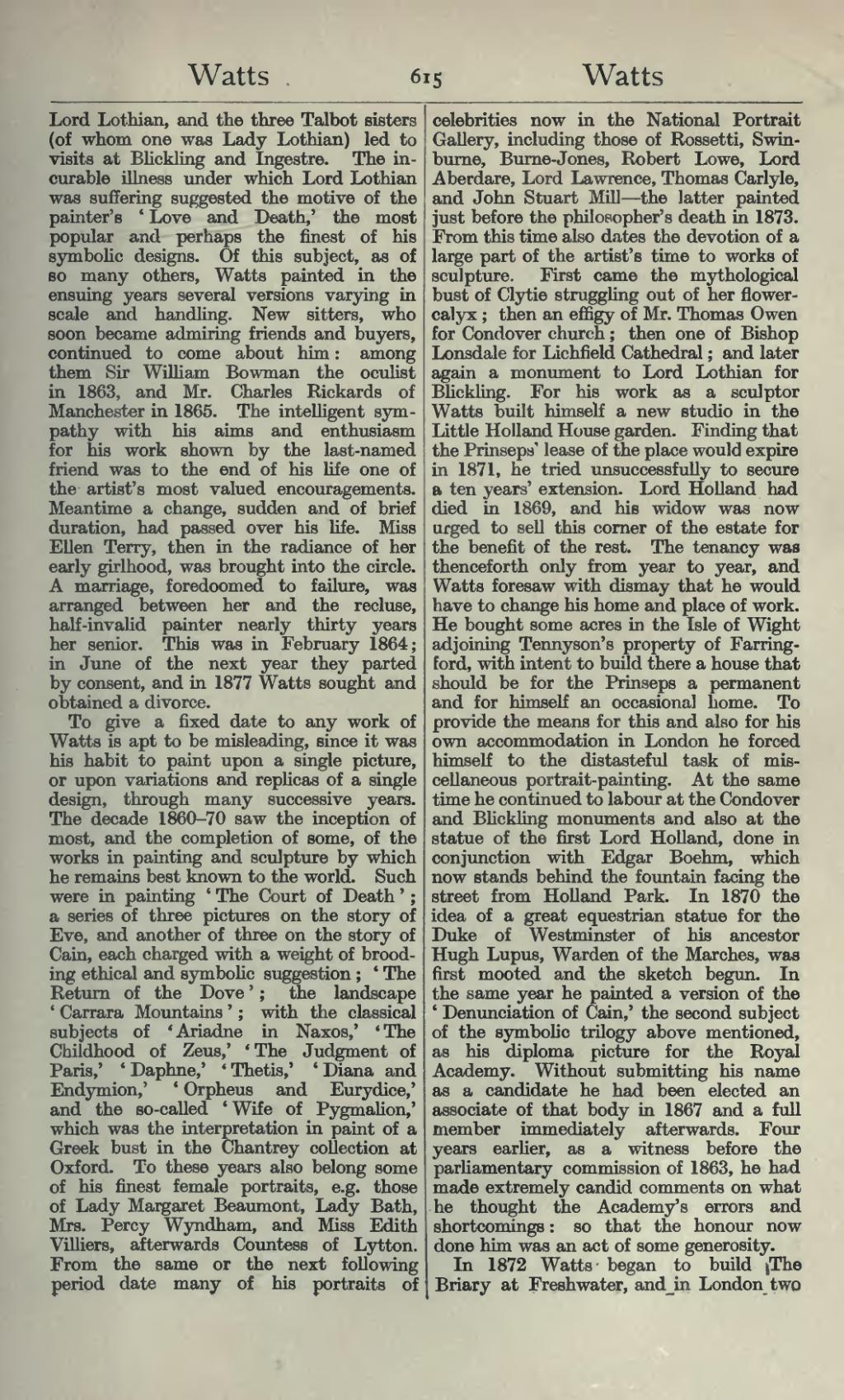Lord Lothian, and the three Talbot sisters (of whom one was Lady Lothian) led to visits at Blickling and Ingestre. The incurable illness under which Lord Lothian was suffering suggested the motive of the painter's ‘Love and Death,’ the most popular and perhaps the finest of his symbolic designs. Of this subject, as of so many others, Watts painted in the ensuing years several versions varying in scale and handling. New sitters, who soon became admiring friends and buyers, continued to come about him: among them Sir William Bowman the oculist in 1863, and Mr. Charles Rickards of Manchester in 1865. The intelligent sympathy with his aims and enthusiasm for his work shown by the last-named friend was to the end of his life one of the artist's most valued encouragements. Meantime a change, sudden and of brief duration, had passed over his life. Miss Ellen Terry, then in the radiance of her early girlhood, was brought into the circle. A marriage, foredoomed to failure, was arranged between her and the recluse, half-invalid painter nearly thirty years her senior. This was in February 1864; in June of the next year they parted by consent, and in 1877 Watts sought and obtained a divorce.
To give a fixed date to any work of Watts is apt to be misleading, since it was his habit to paint upon a single picture, or upon variations and replicas of a single design, through many successive years. The decade 1860–70 saw the inception of most, and the completion of some, of the works in painting and sculpture by which he remains best known to the world. Such were in painting ‘The Court of Death’; a series of three pictures on the story of Eve, and another of three on the story of Cain, each charged with a weight of brooding ethical and symbolic suggestion; ‘The Return of the Dove’; the landscape ‘Carrara Mountains’; with the classical subjects of ‘Ariadne in Naxos,’ ‘The Childhood of Zeus,’ ‘The Judgment of Paris,’ ‘Daphne,’ ‘Thetis,’ ‘Diana and Endymion,’ ‘Orpheus and Eurydice,’ and the so-called ‘Wife of Pygmalion,’ which was the interpretation in paint of a Greek bust in the Chantrey collection at Oxford. To these years also belong some of his finest female portraits, e.g. those of Lady Margaret Beaumont, Lady Bath, Mrs. Percy Wyndham, and Miss Edith Villiers, afterwards Countess of Lytton. From the same or the next following period date many of his portraits of celebrities now in the National Portrait Gallery, including those of Rossetti, Swinburne, Burne-Jones, Robert Lowe, Lord Aberdare, Lord Lawrence, Thomas Carlyle, and John Stuart Mill—the latter painted just before the philosopher's death in 1873. From this time also dates the devotion of a large part of the artist's time to works of sculpture. First came the mythological bust of Clytie struggling out of her flower-calyx; then an effigy of Mr. Thomas Owen for Condover church; then one of Bishop Lonsdale for Lichfield Cathedral; and later again a monument to Lord Lothian for Blickling. For his work as a sculptor Watts built himself a new studio in the Little Holland House garden. Finding that the Prinseps' lease of the place would expire in 1871, he tried unsuccessfully to secure a ten years' extension. Lord Holland had died in 1869, and his widow was now urged to sell this corner of the estate for the benefit of the rest. The tenancy was thenceforth only from year to year, and Watts foresaw with dismay that he would have to change his home and place of work. He bought some acres in the Isle of Wight adjoining Tennyson's property of Farringford, with intent to build there a house that should be for the Prinseps a permanent and for himself an occasional home. To provide the means for this and also for his own accommodation in London he forced himself to the distasteful task of miscellaneous portrait-painting. At the same time he continued to labour at the Condover and Blickling monuments and also at the statue of the first Lord Holland, done in conjunction with Edgar Boehm, which now stands behind the fountain facing the street from Holland Park. In 1870 the idea of a great equestrian statue for the Duke of Westminster of his ancestor Hugh Lupus, Warden of the Marches, was first mooted and the sketch begun. In the same year he painted a version of the ‘Denunciation of Cain,’ the second subject of the symbolic trilogy above mentioned, as his diploma picture for the Royal Academy. Without submitting his name as a candidate he had been elected an associate of that body in 1867 and a full member immediately afterwards. Four years earlier, as a witness before the parliamentary commission of 1863, he had made extremely candid comments on what he thought the Academy's errors and shortcomings: so that the honour now done him was an act of some generosity.
In 1872 Watts began to build The Briary at Freshwater, and in London two
